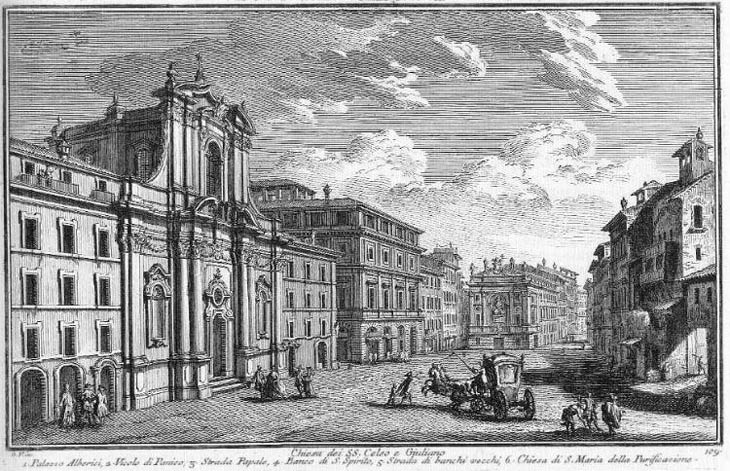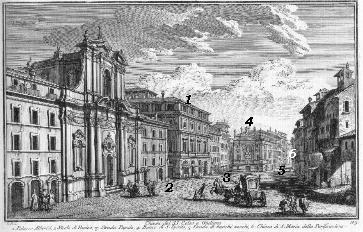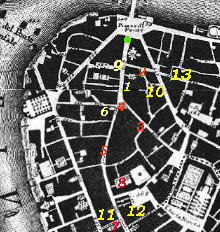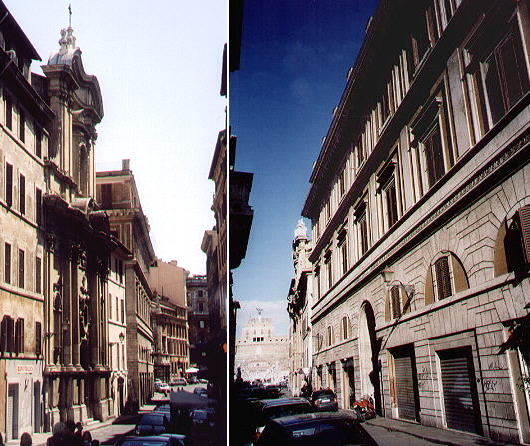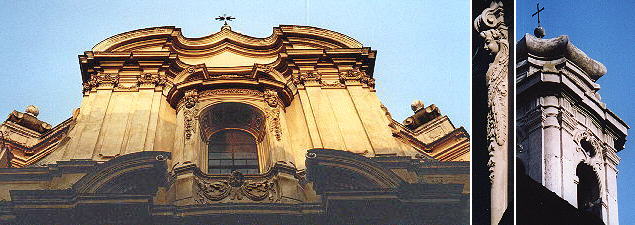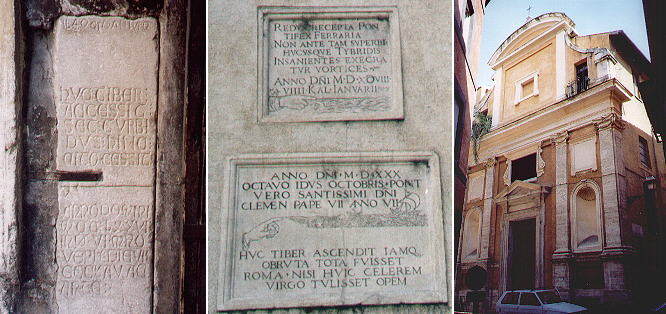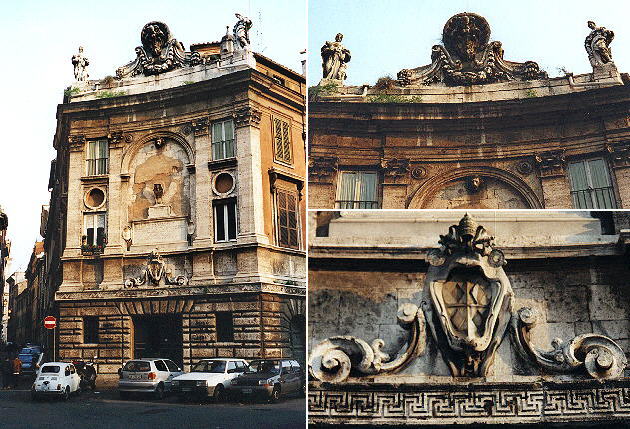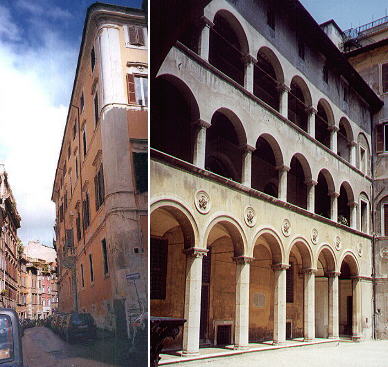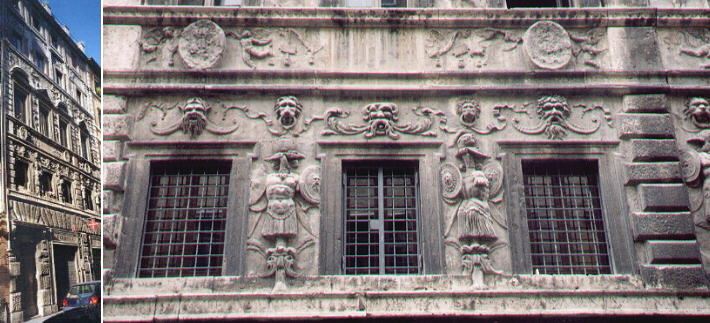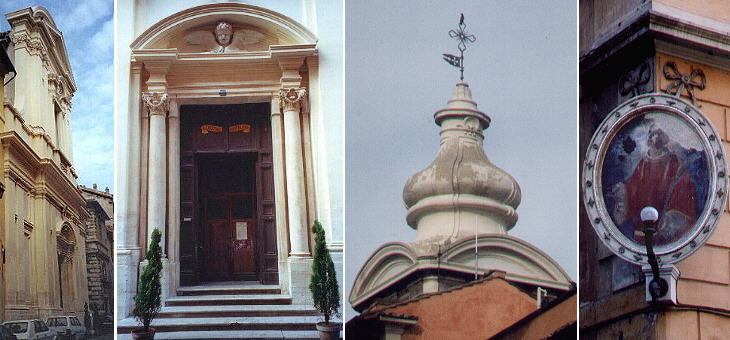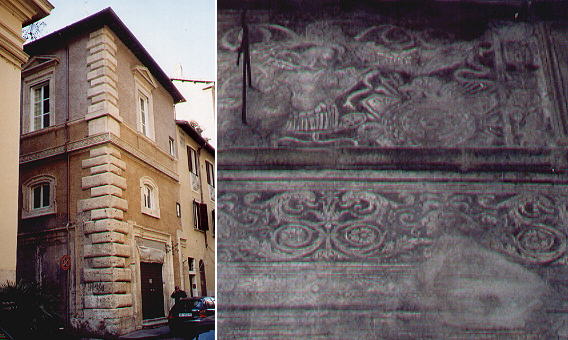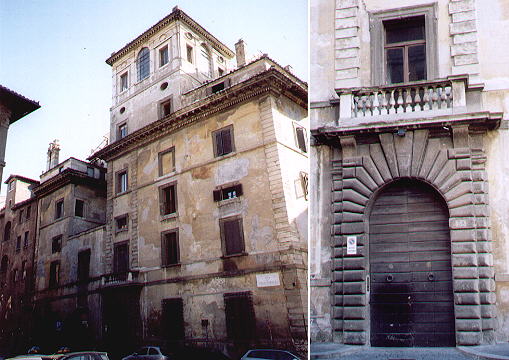  SS. Celso e Giuliano (Book 6) (Day 4 ) and (Day 7 ) (View C4) (Rione Ponte), (Rione Parione) and (Rione Regola) In this page:
This street (currently known as Via del Banco di S. Spirito) on the opposite side offers the striking view of the
Angel's
Bridge and of Castel
Sant'Angelo (see picture of today's view). It is part of the Papal street linking St Peter's with
St John's in Lateran. After his election the Pope went from the Vatican to St John's in Lateran,
which is the Church of the Bishop of Rome. He mounted a white horse (or mule) and during the procession he was paid homage to
by the various communities (including the Jewish one) living in the areas the procession went across. For the occasion ephemeral triumphal arches were built and fake fašades covered
the buildings in poor condition. The view is taken from the green dot in the small 1748 map here below.
In the description below the plate Vasi made reference to: 1) Palazzo Alberici;
2) Vicolo di Panico a small street leading to Via dei Coronari; 3) Papal Street;
4) Banco di S. Spirito; 5) Strada di Banchi Vecchi;
6) S. Maria della Purificazione. The small map shows also 7) S. Lucia del Gonfalone; 8) Palazzo Sforza Cesarini; 9) Arco dei Banchi; 10) Oratorio di S. Celso; 11) Palazzo del Vescovo di Cervia; 12) Casa di Vicolo Cellini; 13) Palazzo Vecchiarelli. The dotted line in the small map delineates
the border between Rione Ponte, Rione Regola (the area around No 7) and Rione Parione (lower right quarter).
Via del Banco di S. Spirito is not the large avenue shown in the plate. The buildings on the Lungotevere are late XIXth century additions and changes are limited although. Palazzo Alberici was modified in the XIXth century and it has now seven windows instead of four. The palace was initially built in the XVIth century.
The church was built by Carlo De Dominicis during the pontificate of Clemens XII and in the plate you can see the pope's coat of arms (now lost) on the top of the fašade. De Dominicis made reference to Borromini's works, in particular to S. Carlo alle Quattro Fontane. Arco dei Banchi e Oratorio di S. Celso
The print by Vasi shows to the right a little arch. One of its pillars has a marble inscription
recording the level of a Tiber flood dating back to 1276: it is the oldest existing record of this kind.
Inscriptions recording Tiber floods can be found in several places in Rome and not only
close to the river such as Porto di Ripetta and
Chiesa di S. Rocco,
but also in areas far from it. The fašade of S. Maria sopra Minerva has
some almost elegant inscriptions recording floods occurred in 1530 and in 1598 (when the highest level was recorded). Palazzo del Banco di S. Spirito
The Pope too needed a bank! Florentine bankers lived in this area and this is still testified by their national church (S. Giovanni dei Fiorentini) and by the names of the streets (Via delle Palle, Via Acciaioli). The Pope felt the need to have a "national" bank and founded it in this building, the Banco di S. Spirito (the Bank of the Holy Spirit). Paulus V's coat of arms is on the top, while on the lower part of the fašade a coat of arms celebrates Clemens IX. Because Banco di S. Spirito was the new bank, the street of the Florentine banks was (and still is) named Via dei Banchi Vecchi (old banks). The little church of S. Maria della Purificazione opposite Banco di S. Spirito was pulled down in 1888. It belonged to the French Nation. Its entrance was walled in the courtyard of Palazzo di S. Luigi.
Palazzo Sforza Cesarini was built by Cardinal Rodrigo Borgia (who became Pope Alexander VI in 1492) when he was appointed Chancellor by his uncle Callistus III. The fašade in Via dei Banchi Vecchi was largely modified in the XVIIIth century and in the late XIXth century the building was in part pulled down and rebuilt to make room for a new large street, Corso Vittorio Emanuele. Only by walking into the courtyard one can see its Renaissance design.
Almost opposite Palazzo Sforza Cesarini there is an interesting house built by a goldsmith from Milan, Gian Pietro Crivelli in 1538. The rich decoration is by Giulio Mazzoni (see Palazzo Spada): the military emblems were familiarly called pupazzi (puppets) and so the palace is known as Palazzo dei Pupazzi (there is another palace by the same name near S. Giuseppe a Capo le Case).
The fašade of S. Lucia was redesigned by Marco David in 1765 and
the interior was the object of many changes in the 1860's, so little is
left of the old church, which was very popular. S. Lucia is the patron
of the sight and the church received votive offerings of golden eyes. Benvenuto
Cellini who lived nearby is known for having offered a golden eye
chiselled by himself. The little church of S. Stefano in Piscivola which was located opposite S. Lucia was pulled
down in the late XIXth century. A sacred image of S. Stefano marks the modern building which replaced the church. After S. Lucia del Gonfalone Via dei Banchi Vecchi
becomes Via di Monserrato. Palazzo del Vescovo di Cervia e Casa di Vicolo Celllini
A narrow street separates S. Lucia del Gonfalone from a Renaissance unfinished palace designed by Antonio da Sangallo il Giovane
for Pietro Fieschi, Bishop of Cervia. It is not the only Renaissance building near the church:
in the nearby alley named after Benvenuto Cellini, a house retains its graffito decoration: the narrowness of the alley
preserved the painting from being damaged by the rain.
This large late Renaissance building was most likely designed by Bartolomeo Ammannati, a
Florentine sculptor and architect who often worked in Rome,
employed by popes and families who came from Tuscany. It is one of the very few historical palaces which has not been repainted in recent years
and because of its current poor state it does not attract a lot of attention, even though it has one of the first and most
elegant Roman loggias.
Next plate in Book 6: S. Tomaso in Parione Next step in Day 4 itinerary: S. Maria in Vallicella Next step in Day 7 itinerary: Chiesa di S. Giovanni dei Fiorentini Next step in your tour of Rione Ponte: Chiesa di S. Giovanni dei Fiorentini Start your tour of Rione Parione: next step: Chiesa di S. Maria in Vallicella Start your tour of Rione Regola: next step: Carceri Nuove
Go
to |
All images © 1999 - 2003 by Roberto Piperno. Write to romapip@quipo.it
